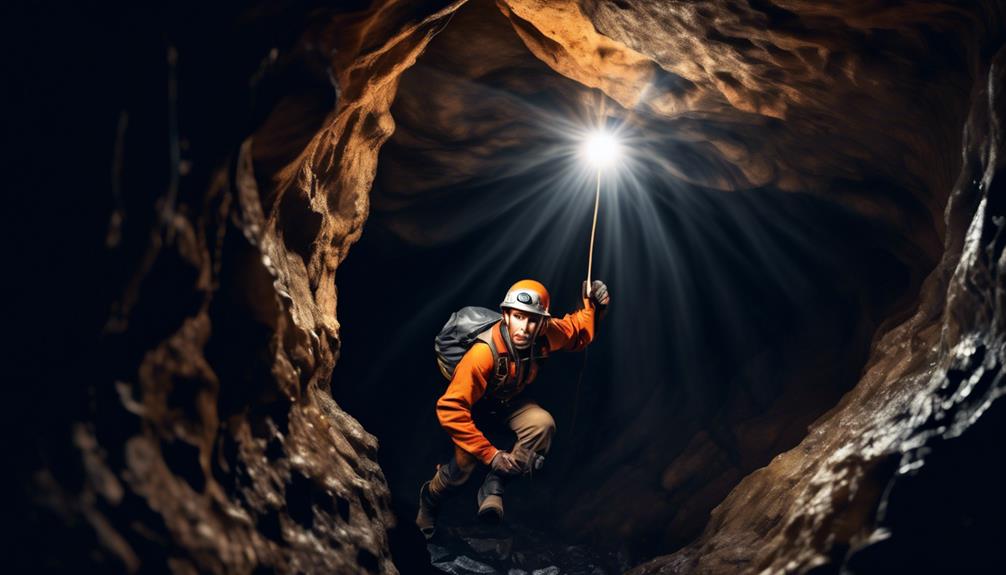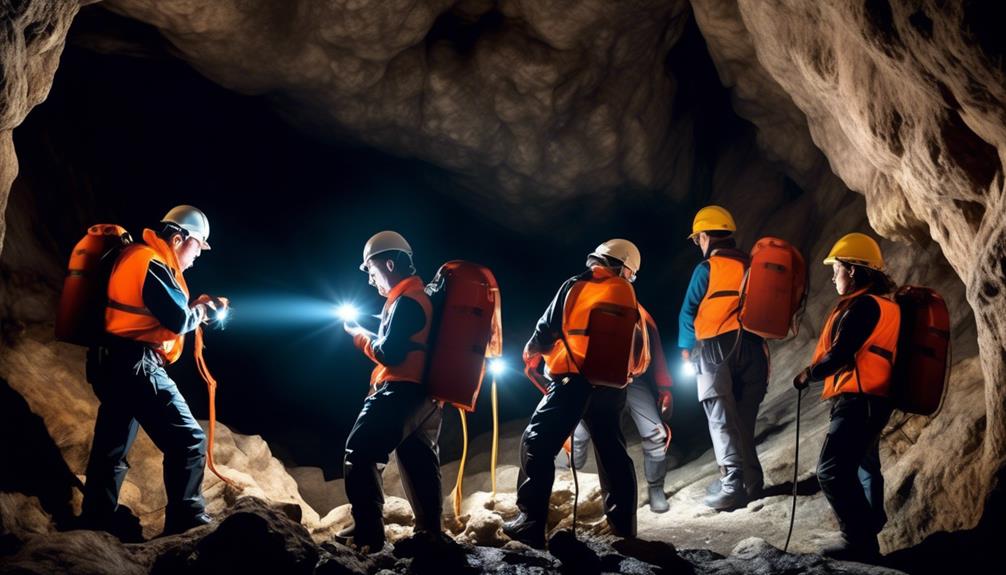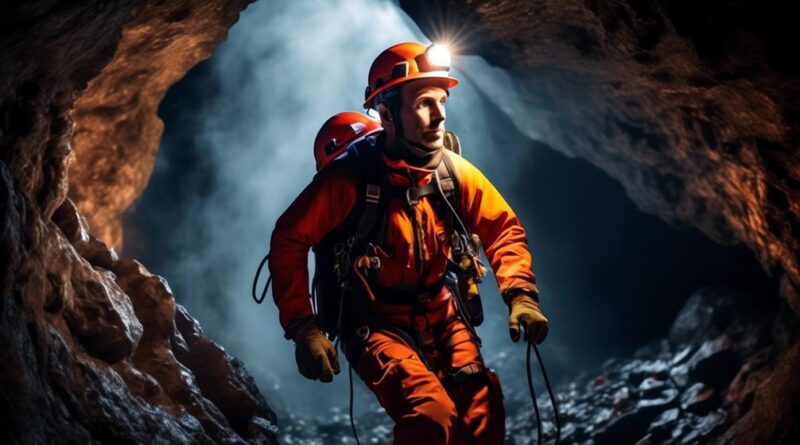What Essential Safety Measures Do Cavers Need?
Are you prepared to handle the unexpected challenges that may arise while exploring underground caves?
When venturing into the depths of the earth, it's crucial to prioritize your safety above all else. From proper equipment to emergency preparedness, the essential safety measures for cavers are numerous and vital.
As you embark on your next caving expedition, it's essential to be well-prepared and equipped with the knowledge and tools to ensure your safety underground.
Proper Equipment
Make sure you have the right equipment before heading into a cave. Proper gear selection and equipment maintenance are crucial for a safe and enjoyable caving experience. Before every trip, carefully inspect your gear to ensure it's in good working condition. Check your helmet for any cracks or damage, and ensure that the headlamp is functioning properly. It's also important to inspect your ropes, harnesses, and carabiners for any signs of wear and tear. Proper equipment maintenance is essential for your safety underground.
When it comes to gear selection, choose equipment that's specifically designed for caving. This includes a sturdy helmet, reliable headlamp, durable ropes, and a harness with proper support. Opt for gear that's lightweight yet durable, as you'll need to carry it throughout your journey. Additionally, consider the environment you'll be caving in and select gear that's suitable for the specific conditions, such as wet or dry caves.
In addition to selecting the right gear, it's important to maintain it properly. After each caving trip, thoroughly clean and inspect your equipment. This includes removing any dirt or debris from your gear and checking for any signs of damage. Proper equipment maintenance not only ensures your gear lasts longer but also minimizes the risk of equipment failure during future caving expeditions.
Emergency Preparedness
In case of an emergency while caving, ensure you have a well-stocked first aid kit readily accessible and that you and your group are trained in basic first aid procedures. Emergency response in caves can be challenging, so it's crucial to have the skills and supplies necessary to handle unexpected situations.
When it comes to emergency preparedness, cavers should also prioritize survival skills. This includes knowing how to stay warm, finding potable water, and signaling for help if needed.
While caving, it's important to have a plan for emergency response. Make sure everyone in your group knows what to do in case of an emergency, including how to communicate, where to meet, and how to seek help if someone is injured or lost.
Survival skills are also essential. Knowing how to start a fire, build a shelter, and navigate in the dark can be life-saving in emergency situations. Additionally, having the right equipment, such as a reliable light source, extra food and water, and a multi-tool, can greatly enhance your ability to respond to emergencies effectively.
Physical Fitness

Maintaining good physical fitness is crucial for cavers to ensure endurance and strength during cave exploration. As a caver, your physical condition directly impacts your ability to navigate through challenging cave systems safely.
Here's why injury prevention and conditioning are essential for your health and stamina:
- Injury Prevention:
- As you maneuver through tight spaces and uneven terrain, being in good physical shape can help you avoid strains, sprains, and other common caving injuries. Your muscles and joints need to be conditioned to handle sudden movements and support your body weight in various positions, reducing the risk of accidents.
- Conditioning for Stamina:
- Caving often requires prolonged periods of physical exertion, such as climbing, crawling, and lifting. By maintaining a high level of fitness, you can increase your stamina and reduce fatigue, allowing you to explore caves for longer periods without compromising your safety. Improved cardiovascular health and muscular endurance are crucial for enduring the demanding nature of caving expeditions.
Environmental Awareness
Developing a keen sense of environmental awareness is crucial for cavers as it enhances your ability to respect and protect delicate cave ecosystems. When exploring caves, it's essential to be mindful of your ecological impact. The fragile balance of cave ecosystems can be easily disrupted by human activity. By being environmentally aware, you can minimize your impact and help preserve these unique environments for future generations.
Cavers should be conscious of the potential ecological impact they can have on cave systems. The delicate formations and inhabitants of caves can be easily damaged by careless behavior. For instance, touching stalactites and stalagmites can disrupt their growth, and disturbing cave-dwelling creatures can have long-lasting effects on their populations. Being aware of the potential consequences of your actions is the first step in minimizing your ecological impact.
Conservation efforts are also a crucial aspect of environmental awareness for cavers. Many caves are home to rare and endangered species, making it important to support conservation initiatives. By staying informed about conservation efforts and contributing to relevant causes, you can actively participate in preserving these unique ecosystems. Additionally, spreading awareness about the importance of cave conservation within the caving community and beyond can help garner support for these vital efforts.
Communication Protocol
Regularly updating your fellow cavers on your location and any potential hazards is essential for maintaining a safe and coordinated exploration experience. Effective communication within a caving team can prevent accidents and ensure everyone's well-being. Here are some key points to consider in establishing an effective communication protocol:
- Establishing Check-in Points
Setting specific intervals or locations where the team gathers to check in ensures that everyone is together and accounted for. This practice also allows for any changes in the plan to be communicated effectively.
- Using Emergency Signals
Agreeing on clear and distinct signals for emergencies is vital. For example, three short whistle blasts or a specific light pattern can indicate distress and the need for immediate assistance.
Having a communication plan in place helps to mitigate potential risks and ensures that everyone in the caving team is informed and safe. Effective communication is a fundamental aspect of caving safety, and understanding and utilizing emergency signals can make a significant difference in the event of an unforeseen circumstance.
Safety Protocols
To ensure the safety of your caving team, it's crucial to establish clear safety protocols that build upon the effective communication practices previously discussed. When it comes to emergency procedures during cave exploration, it's essential to designate a team member as the point of contact on the surface. This person should be responsible for initiating outside help if needed. Additionally, establish a set of signals or communication methods that can be used in case of separation or emergency.
Safety guidelines for cave formations are equally important. These protocols should emphasize the importance of not touching any cave formations, as the oils and dirt from human skin can disrupt the natural growth and preservation of these delicate structures. It's also important to establish a protocol for movement within the cave to ensure that everyone stays together and follows a predetermined route. Having clear guidelines on how to navigate tricky terrain or obstacles can prevent accidents and keep the team safe.
In the event of an emergency, it's crucial to have a thorough understanding of the cave's layout and potential exit points. Establish a protocol for conducting regular headcounts to ensure that everyone is accounted for. Furthermore, ensure that all team members are familiar with basic first aid procedures and have access to emergency supplies.
Risk Assessment

Assess potential risks by thoroughly examining the cave environment and identifying any hazardous conditions or factors that could jeopardize the safety of your team. Start by conducting a comprehensive hazard identification process, which involves recognizing potential dangers such as unstable rock formations, narrow passages, or slippery surfaces. Mitigate these hazards by implementing control measures, which may include reinforcing unstable areas, using proper lighting and navigation tools, and wearing appropriate protective gear.
Establishing a strong safety culture within your caving team is crucial. This involves fostering an environment where every member feels comfortable raising safety concerns and actively participating in risk assessment and mitigation efforts. As a leader, it's essential to promote open communication and ensure that all team members are knowledgeable about the potential risks associated with the cave environment.
Encouraging a proactive approach to safety will help create a vigilant team that's constantly aware of their surroundings and ready to address any hazards that may arise.
Training and Education
Establishing a strong foundation for safety in caving involves several key elements. First and foremost, it is crucial to ensure that your caving team receives thorough training and education on cave exploration techniques and potential hazards. This training should cover a range of practical skills that are essential for safe caving, such as rope techniques, climbing, rappelling, and using specialized equipment. It is important to practice these skills under the guidance of experienced cavers to ensure competency.
In addition to practical skills, developing a strong knowledge base is vital for safe caving. This includes understanding cave geology, hydrology, and the behavior of cave-dwelling organisms. Having this knowledge can help cavers make informed decisions and minimize their impact on the cave environment.
Furthermore, your education should also include learning about emergency procedures and rescue techniques. Caving can involve unpredictable situations, such as getting lost, encountering a medical emergency, or being trapped by rising water. Being prepared for these unexpected scenarios is essential. Training in first aid and wilderness medicine is crucial, as it equips cavers with the skills to administer aid in a cave environment where professional medical help may be hours away.
Frequently Asked Questions
Are There Any Specific Safety Measures That Need to Be Taken for Caving in Different Types of Geological Formations (E.G. Limestone Caves, Lava Tubes, Etc.)?
When caving in different geological formations like limestone caves or lava tubes, it's crucial to consider specific safety measures. These formations present unique challenges, such as potential for rockfalls in limestone caves or uneven terrain in lava tubes.
It's essential to be prepared for potential caving injuries, extreme weather, and the environmental impact. Additionally, being in remote locations means you should always have a plan for communication and emergency response.
What Are the Most Common Injuries or Accidents That Occur in Caving, and How Can They Be Prevented?
To prevent accidents while caving, it's crucial to stay aware of common injuries like slips, falls, and equipment malfunctions.
First aid training is essential for handling potential emergencies underground.
Always ensure you have the right gear and are familiar with your surroundings.
Stay connected with your group and communicate effectively.
Being prepared and cautious can help reduce the risk of accidents and ensure a safer caving experience.
Are There Any Specific Safety Measures for Caving in Extreme Weather Conditions, Such as Heavy Rain or Snow?
In extreme weather conditions like heavy rain or snow, safety precautions are crucial for caving. Weatherproof gear and emergency plans should be in place to ensure your safety.
When caving in such conditions, always check weather forecasts and have a clear exit strategy. Be prepared for changing conditions and potential hazards.
Your safety in extreme weather while caving depends on careful planning and the right gear.
How Can Cavers Ensure They Are Not Disturbing the Natural Environment or Wildlife While Exploring Caves?
To minimize impact and preserve wildlife while exploring caves, be mindful of your surroundings. Avoid disturbing natural formations, such as stalactites and stalagmites.
Stick to designated paths and avoid trampling vegetation. Keep noise levels low to not disturb wildlife.
Carry out all waste and trash to leave the environment undisturbed. By respecting the natural habitat, you can enjoy cave exploration while preserving the delicate ecosystem.
Are There Any Safety Measures or Protocols Specifically for Caving in Remote or Isolated Locations?
When caving in remote or isolated locations, it's crucial to prioritize safety. Equipment maintenance ensures gear reliability, while emergency communication devices like satellite phones offer a lifeline.
Group dynamics are key for support and problem-solving. Psychological preparation helps manage stress and fear.
Always have a plan and stick together. It's about being proactive and ready for anything in those remote areas.
Conclusion
So, as a caver, remember to always be prepared with the right equipment, stay physically fit, be aware of your environment, communicate with your team, and follow safety protocols.
By assessing risks, getting proper training, and staying educated, you can ensure a safe and enjoyable caving experience.
Stay safe and happy caving!
